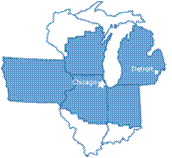Seventh District Update

A summary of economic conditions in the Seventh District from the latest release of the Beige Book and from other indicators of regional business activity:
- Overall conditions: Economic activity in the Seventh District continued to expand at a slow pace in January and February.
- Consumer spending: Consumer spending increased at a slower rate. Retailers pointed to the negative impacts on household budgets from rising gas prices and the end of the payroll tax holiday as explanations for the slower pace of retail sales. Auto sales were steady for much of the reporting period before increasing slightly over the last few weeks.
- Business Spending: Growth in business spending slowed. Inventory investment declined, and spending on equipment and structures was again limited. Labor market conditions were little changed.
- Construction and Real Estate: Construction and real estate activity was mixed. Demand for residential construction continued to increase slowly, buoyed by ongoing strength in multifamily construction. Although there was some modest growth in nonresidential construction, the level of activity remains weak.
- Manufacturing: Growth in manufacturing production picked up over the reporting period. The auto industry remained a source of strength, with light vehicle sales expected to increase throughout the year. Demand for heavy equipment weakened, with lower coal prices contributing to less mining activity.
- Banking and finance: Credit conditions continued to ease. Credit spreads and financial market volatility remained low and asset quality continued to improve. Banking contacts reported moderate growth in business and consumer loan demand, with pricing relatively unchanged but some loosening of loan standards.
- Prices and Costs: Cost pressures were moderately higher. Contacts noted some upward pressure on raw materials prices, particularly for lumber, drywall, steel, aluminum, and copper. Wage pressures remained moderate.
- Agriculture: Snow and rain continued to boost topsoil moisture levels, although depleted subsurface moisture remained a concern for farmers. Corn, wheat, milk, hog, and cattle prices dipped during the reporting period, while soybean prices moved a little higher.
The Midwest Economy Index (MEI) increased to –0.18 in December from –0.30 in November, but remained negative for the sixth consecutive month. The relative MEI decreased to –0.01 in December from +0.55 in November, primarily because of significantly lower contributions from the Midwest’s manufacturing and service sectors.
The Chicago Fed Midwest Manufacturing Index (CFMMI) increased 0.7% in December, to a seasonally adjusted level of 94.7 (2007 = 100). Revised data show the index was up 2.0% in November. The Federal Reserve Board’s industrial production index for manufacturing (IPMFG) moved up 0.8% in December. Regional output rose 6.2% in December from a year earlier, and national output increased 2.7%.








